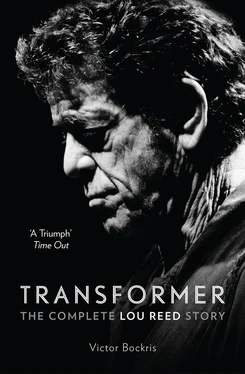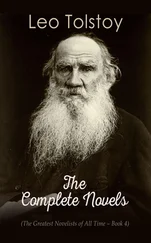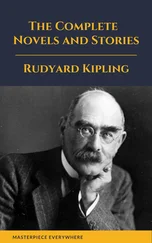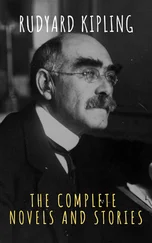This fortuitous opportunity was pivotal for their career. First, since there was so little time between the two dates, they decided to keep Maureen, initially much to Cale’s chagrin. Moe remembered standing in the street with John, who kept saying, “No chicks in the band. No chicks.” Second, at the very time they were playing at the Cafe Bizarre to unreceptive tourists twice a night for $5 apiece per night, the pop artist and entrepreneur Andy Warhol was looking around for a group to manage for a nightclub he had been asked to host by the theatrical impresario Michael Myerberg (who had brought Beckett’s Waiting for Godot to the USA in 1956). Barbara Rubin, for whose film Christmas on Earth the band had played in their previous incarnation, was spending a good deal of time at the Warhol studio, the famous Silver Factory, and thought the Velvets would be the perfect band for Warhol’s upcoming discotheque. She took two of Warhol’s leading talent scouts, the film director Paul Morrissey and the underground film star Gerard Malanga, to see them. Malanga, who has just starred in Warhol’s version of A Clockwork Orange , Vinyl , was an outstandingly handsome young man with a potent sexual aura. Combining the looks of Elvis Presley and James Dean with the long hair of Mick Jagger, Malanga dressed head to foot in black leather and carried, purely for dramatic effect, a black leather bullwhip, which he wore wrapped around the shoulder of his jacket. During the Velvets’ set, Gerard suddenly leapt up from his table onto the empty dance floor. All of the other customers were too terrified by the music to move. Making ample use of his whip, he undulated in a sinister, erotic dance that perfectly illustrated the visceral, throbbing music. The band was dumbfounded by Gerard’s mind-blowing performance. In the intermission Lou and John went over to his table and told him to come back and dance anytime. Instantly spotting a starring role for himself in the scenario, Malanga thought the group would be perfect for Warhol.
Lou performing in the Paraphernalia footage of Gerard Malanga’s Film Notebooks , 1966. (Victor Bockris)
The following night Malanga returned to the Cafe Bizarre with Rubin, Warhol’s business manager Paul Morrissey, and Warhol himself, accompanied by an entourage including his reigning superstar Edie Sedgwick. They were thrilled by the weird and raucous performance of the Velvet Underground. Not only did the group do the same thing Warhol’s films did—make people uncomfortable—but their name, and the fact that they sang about taboo subjects, perfectly fit Warhol’s program. To top it off, Morrissey was intrigued by the band’s androgynous drummer. After the set Barbara brought the Velvets over to Andy’s table. The curly-haired Lou Reed, with his shy smile, shared a temperament with Warhol. He sat next to the pop artist and the two of them immediately hit it off. “Lou looked good and pubescent then,” Warhol recalled. “Paul thought the kids out on the Island would identify with that.”
Morrissey, who was the most influential person in Warhol’s world after Malanga, was fascinated: “John Cale had a wonderful appearance and he played the electric viola, which was a real novelty; but best of all was Maureen Tucker, the drummer. You couldn’t take your eyes off her because you couldn’t work out if she was a boy or a girl. Nobody had ever had a girl drummer before. She made no movement, she was so sedate. I proposed that we sign a contract with them, we’d manage them and give them a place to play.”
“We looked at each other,” Lou Reed remembered, “and said, ‘This sounds like really great fun.’”
Chapter Six
1966
Reality was the key.
Lou Reed
When Andy met the Velvets, they were unglamorous and unknown. “Andy, the problem is these people have no singer,” said Paul Morrissey. “There’s a guy who sings, but he’s got no personality and nobody pays the slightest attention to him.” In the following days Warhol and Morrissey transformed them from a four-piece unit led by Lou to a band fronted by the stunningly beautiful singer-actress Nico, a statuesque German blonde who had walked into Warhol’s studio a week earlier. Lou initially didn’t want her to be their chanteuse, but the arrangement was worked out under the convincing influence of Warhol’s business manager, Paul Morrissey, who “just didn’t think Lou had the personality to stand in front of the group and sing. The group needed something beautiful to counteract the screeching ugliness they were trying to sell, and the combination of a beautiful girl standing in front of all this decadence was what was needed. Right away that sour little Lou Reed bristled. He was hostile to Nico from the start. I told them I thought that Nico could be part of the Velvet Underground and just fit in there under that name.” Quick to grasp the essence of the problem, Lou replied, “Let’s keep Nico separate in this. The Velvet Underground—and Nico.”
“Andy was this catalyst, always putting jarring elements together,” Lou noted. “Which was something I wasn’t so happy about. He wanted us to use Nico. Andy said, ‘Oh, you’ve gotta have a chanteuse.’ I said, ‘Oh, Andy, give us a break.’ But we went along with it at the time. Andy wanted her so he got her.” Unbeknownst to Lou, back in 1963 Andy had tried to put together his own rock-and-roll band with none other than La Monte Young and Walter De Maria. Now, in as much as Warhol saw himself in Nico, Andy could fantasize that he was fronting the band.
The most remarkable thing about Lou Reed’s progress in 1966 was his uncharacteristic willingness to accept Warhol’s control in order to achieve the extraordinary success it would bring him. But, in the process, Lou made something of a Faustian bargain with Andy. Warhol had miraculously pulled the group out of the toilet, elevating them to his level when he was at the height of his fame. In exchange, however, Andy demoted Lou from fronting the band to being, employing a phrase by Nico, its “janitor of lunacy.” Imagine what would have happened if Andrew Loog Oldham had tried to pull the same moves on Mick Jagger, promoting, for example, Brian Jones over his head as the front man, or indeed if Brian Epstein had suggested to John or Paul that they take a backseat in the Beatles and let George Harrison come up and front them. It is very rare that rock groups in their first flush of success find lead singers and songwriters willing to bow into a background role at the very moment of their initial triumph. It revealed several sides of Lou. First, his ambivalence about being in the spotlight. Second, his unusual ability to accept what would be best for the band without thinking about his own fame. Third, his discipleship to Andy Warhol.
Andy choreographed his group within a context that had been predicted by one of Lou’s favorite writers, Edgar Allan Poe, who wrote one hundred years earlier, “The next step may be the electrification of all mankind by the representation of a play that may be neither tragedy, comedy, farce, opera, pantomime, melodrama or spectacle, as we now comprehend these terms, but which may retain some portion of the idiosyncratic excellence of each, while it introduces a new class of excellence as yet unnamed because as yet undreamed of in the world.” It was also based on—some people said ripped off from—the 1965 multimedia performances of La Monte Young and Piero Heliczer as well as the “happenings” that were rife in the art world of the early sixties. In the band’s first performance, at a dinner for a psychiatrists’ convention at the elegant Delmonico’s Hotel on Fifth Avenue in New York on the night of January 13, 1966, the group turned the tables on their audience, putting on an act of resentment and rage that Lou characterized as “fun.”
Читать дальше












